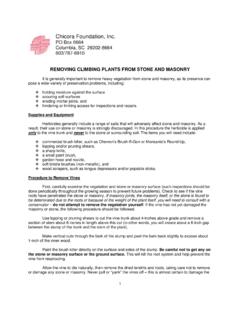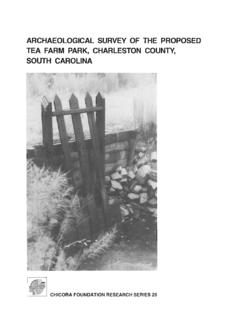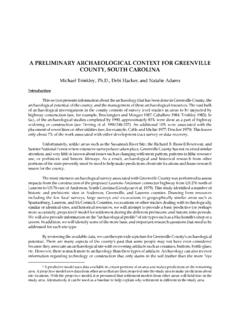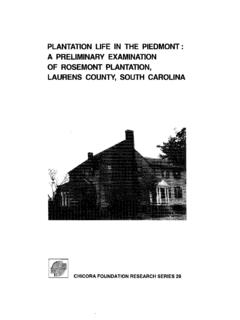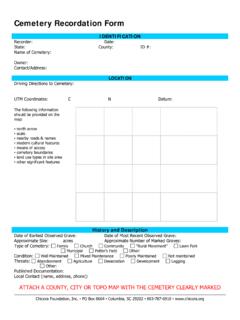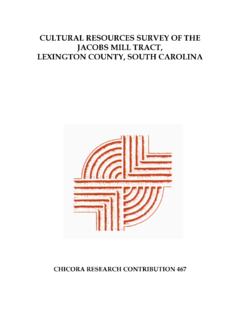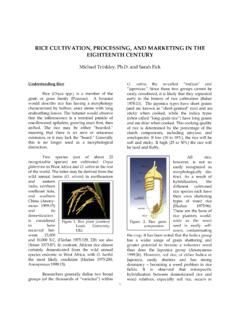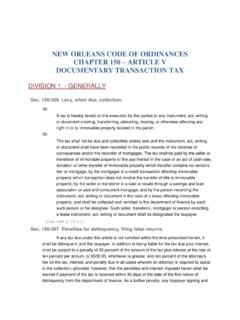Transcription of Cemetery Disaster Planning - Chicora
1 Cemetery . Disaster . Planning . 2013 Chicora Foundation, Inc. Is your Cemetery prepared for the unexpected, such as a tornado, hurricane , earthquake, or flood? Do you have a plan to minimize damage and recover afterwards? If not, this publication can help you, your staff, and your volunteers prepare for the unthinkable. The cover photograph is of the Muncie, Indiana Beech Grove Cemetery during the March 1913 flood. Rainfall of 6 inches to 8 inches fell in Muncie from the afternoon of March 23 through the afternoon of March 26, changing to snow late on the 26th. Accumulations reached 1 to 2 inches by the following day and the river crested at feet on March 25th, the highest level ever recorded. When floodwaters finally receded, at least 200 Indiana residents had lost their lives. The Great Flood of 1913 affected the entire midwestern section of the United States and resulted in at least 600 deaths. Chicora Foundation, Inc. PO Box 8664. Columbia, SC 29202-8664.
2 803-787-6910. TABLE OF CONTENTS. Does Your Cemetery Have A Plan 1. How Disasters Affect Your Cemetery 2. Hurricanes 2. Tornadoes 3. Flooding 4. Other Disasters 5. Evaluate Your Risks 7. Getting Ready 8. Trees 8. Other Vegetation 9. Drains 9. Dangerous Monuments 10. A Lot Depends on Your Staff 11. Training 12. Budget Considerations 12. Equipment and Supplies 12. Pre-establish Contacts 13. Inventories and Mapping 14. Storage of Critical Data 14. Loss of Human Remains 15. Before the Event 16. Little or No Warning 16. Minimal Warning 17. With Adequate Time 17. After the Event 18. First, Safety 18. Documentation 19. Road Clearing 20. Grounds Clearing 20. Monuments 22. Insurance 23. FEMA 24. Plot Owners 25. So You Have A Plan 25. Additional Sources 26. Cemetery Disaster Planning Cemetery Disaster Planning DOES YOUR Cemetery HAVE A PLAN? A 2005 study by the World Bank and Columbia University found that the number of disasters worldwide has been steadily increasing.
3 Flood and wind events, in particular, have caused much greater economic loss. Much of the United States falls into a region identified as a multi-hazard, high-mortality, and total economic loss hotspot. These areas will require huge amounts of future Disaster relief funding. In fact, the world's largest reinsurer, Munich Re, recently released a study showing the escalating cost of disasters . both to insurers and to those lacking insurance. Meteorological events, including tropical storms, winter storms, severe weather, hail, tornadoes, caused 59% of all losses. The other Disaster classes, including geophysical events (such as earthquakes), hydrological events (such as floods), and climatological events (such as wildfire and drought) each account for between 12 and 16% of the disasters. However you look at it, the costs of not being prepared are escalating. Cemeteries can be affected by a range of significant climatic disasters, including river flooding, hurricane winds, storm surges, tornadoes, and drought.
4 In addition, issues such as vandalism, theft, and even homelessness can cause significant harm to the Cemetery landscape. So, does your Cemetery have a plan? A plan to mitigate or minimize as much risk as possible? A plan for recovery should the unthinkable actually happen? Chances are you don't . and that is likely to make the Disaster far worse through indecision and inappropriate actions. This brochure will help your Cemetery understand the risk, take precautions, and plan for recovery. But this isn't a replacement for careful study, coordination with local emergency management agencies, or discussions with your Cemetery governing board and attorney. Page 1. Chicora Foundation, Inc. HOW DISASTERS AFFECT YOUR Cemetery . It's important to understand that your Cemetery is vulnerable, as well as to realize the nature of the damage that you face. Let's examine a few of the more common disasters. Hurricanes Hurricanes result in wind and water damage.
5 A Category 1 hurricane will have sustained winds of 74-95 mph. A Category 4. hurricane will have sustained winds of 131-155 mph. These winds will damage vegetation, removing branches or entire trees. They will blow other debris into your Cemetery , including awnings, sheds and marsh grass. Even boats have been blown and washed into cemeteries. And the sand will scour stones. Trees will topple and crush monuments. Debris will complicate your clean-up efforts. Salt water spray will kill or damage many plants. The wind may damage structures on your Cemetery 's property (such as your office), as well as destroy signage. You will probably be without power anywhere from a few days to weeks. hurricane Katrina flooded this New Orleans, Louisiana Cemetery . Water is never just water. It contains sewage, toxic waste, and other contaminants. It may also include large quantities of salt that will damage your stones and kill vegetation (Photo courtesy FEMA).
6 Hurricanes may also result in a storm surge water pushed toward the shore by the force of the winds. Much of our coast lies less than 10 feet above mean sea level. The surge is dependent on local factors, forward speed, size, central pressure, and even the angle of approach to the coast, not just the category of the hurricane . You should consult NOAA weather forecasts for storm surge information. Pay particular attention to what are called the SLOSH (Sea Lake Overland Surge [from] Hurricanes) models. If your Cemetery is in a hurricane prone area (take a look at the map below), be certain that you begin Planning for hurricane season (June 1 through November 30 on the East Coast and May 15 through November 30 on the Pacific Coast). This map shows anticipated maximum wind speeds along the Eastern Coast (Courtesy ASCE 7-98). Page 2. Cemetery Disaster Planning Water is an incredible force, weighing about 1,700 pounds per cubic yard. Structures, including mausoleums, can be destroyed by the pounding of waves.
7 Coastal areas can experience erosion. The surge can transport anything in its way into your Cemetery including buildings and boats. Rainfall associated with a hurricane can also cause extensive damage building roofs can leak; the ground can become saturated allowing trees to topple; drains can become clogged resulting in flooding; and below ground vaulted burials can float to the surface. Tornadoes A tornado can change your Cemetery in a matter of minutes. The Fujita scale classifies tornadoes into six intensities, from F0 (with wind speeds of 40-72 mph) to F5 (with wind speeds of 261-318 mph). A tornado heavily damaged this Raleigh, NC. Cemetery , taking down trees and crushing stones (Photo courtesy FEMA). F0 and F1 tornadoes (wind speeds from 40 to 112 mph) account for about 69% of all such storms and typically last for 1-10 minutes (sometimes longer). It's important to understand that a 100 mph wind results in wind pressure of about 25 pounds per square foot.
8 For an obelisk 30 feet high that translates into a wind load of about 1,560 pounds. You can expect an F2 tornado to topple trees and even overturn boxcars. Structures with weak foundations will be picked up and moved. The map below identifies the more tornado prone areas in the United States. Tornado risk map for the United States (Courtesy FEMA). Page 3. Chicora Foundation, Inc. hurricane Categories and the Fujita Scale for Tornadoes Hurricanes Tornadoes Category 1 74-95 mph; large branches will F0 40-72 mph; light damage; branches snap and shallow rooted trees removed from trees; shallow rooted trees may topple; extensive damage topple; typically last from 1-10+ minutes to power lines Category 2 96-110 mph; many shallow F1 73-112 mph; peels surface off roads;. rooted trees will topple; near outbuildings demolished trees snapped or total power loss expected for broken; moving autos pushed off roads several weeks Category 3 111-130 mph; many trees F2 113-157 mph; roofs torn off frame snapped or uprooted; houses; boxcars pushed over; large trees electricity and water will be snapped or uprooted unavailable for several weeks Category 4 131-155 mph; most trees will F3 158-206 mph; trains overturned; most be snapped or uprooted; trees in forests uprooted; cars lifted up power outages will last for and thrown; weak pavement blown off weeks to months roads Category 5 >155 mph; nearly all trees will F4 207-260 mph; well constructed homes be snapped or uprooted; leveled; cars thrown and disintegrated.
9 Power outages will last for trees uprooted and carried away weeks to months F5 261-318 mph; incredible damage; auto sized missiles fly through the air in excess of 300 feet; trees debarked; can last for 20 minutes or longer Flooding Floods can be caused by heavy rains, ice jams, rains after fires, levee breaks, spring thaw, new development, tropical storms, and hurricanes. High risk areas are those shown on FEMA flood maps as Special Flood Hazard Areas (SFHAs). These areas have at least a 1% annual chance of flooding this is considered the 100 year flood. An area with a annual chance of flooding is within the 500 year flood zone. Flooding from hurricane Ike displaced caskets and opened vaults throughout this Texas Cemetery (Photo courtesy FEMA). Page 4. Cemetery Disaster Planning One study found over 40 million people live in flood prone areas, including nearly million in coastal counties. This represents over 17 million housing units and an unknown number of cemeteries.
10 Flood water can move at speeds of up to 12 mph. For each foot of flood water, 1500 pounds of an automobile's weight is displaced. This means that two feet of water has more than enough energy to send most automobiles floating helplessly downstream. Floods can also transport trees, boulders, and other debris. They can destroy underground utilities and the roads themselves. In addition, flood waters can saturate the ground and displace caskets and vaults. There have been multiple cases where cemeteries were flooded and caskets were displaced. As a result of the Missouri River flooding in 1993, 700 of the 1,500 graves in the Hardin, Missouri Cemetery were displaced. A year afterwards only 100 could be securely identified. Nearly 150 remains were never identified. In 1994, the flooding of the Flint River again displaced more than 400 caskets in two Albany, Georgia cemeteries. hurricane Floyd in 1999 displaced over 200 caskets from North Carolina cemeteries.
